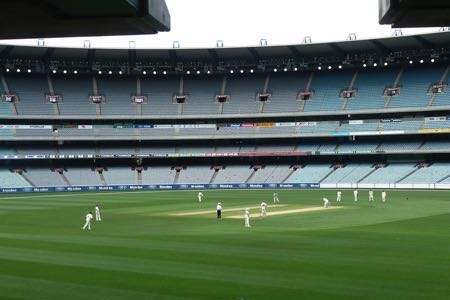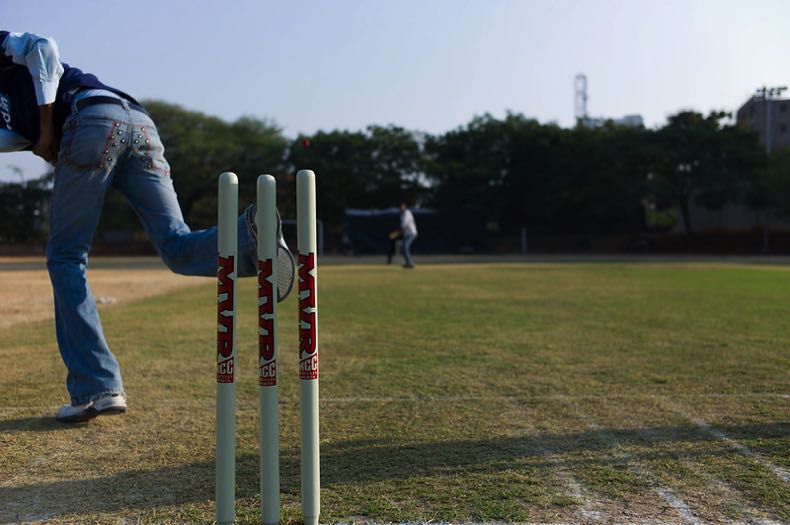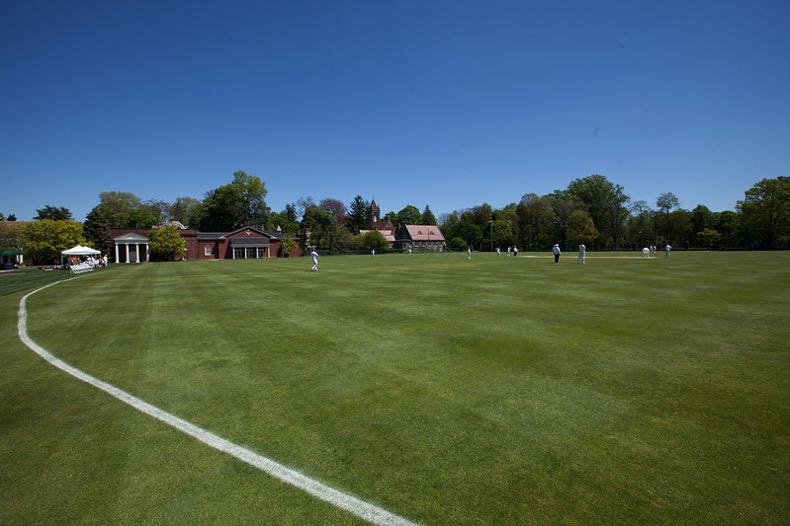
When thinking about cricket pitches and their size, it is important to differentiate between the pitch and the field. In football and rugby, the entire grass playing area is called the pitch but in cricket this is not true. The green area you see elsewhere in a cricket oval is the outfield, while only the firm rectangular strip in the centre is called the ‘pitch’.
In this article we will detail the length of a cricket pitch, describe the various elements of a cricket pitch, and also discuss whether pitch sizes vary depending on the type of cricket game being played.
Pitch Length

This gets even more complicated now. The flat, rectangular strip cut very short will have room either side of the ‘wicket’ and more behind each set of stumps. Measurements here may differ ever so slightly. The ‘pitch’ itself runs from one set of stumps to the other, along the line of the bowling crease, and is 22 yards. This is 66 feet in total.
66 feet or, much more pertinently 22 yards, is an important measurement. 22 yards is counted as one ‘chain’. This old measurement was used frequently once upon a time, including in sport. Ten chains amount to 220 yards, or one furlong. Eight furlongs equals a mile with miles, furlongs and yards used to this day in British, Irish and American horse racing.
In truth, many modern people will simply think that furlongs were used exclusively in or even invented by horse racing, but that is not true. In their use of these measurements, cricket and horse racing are inextricably linked. Football fields can differ slightly in size, as can other sporting venues. Cricket outfields too can differ, but the solid one-chain cricket pitch became very important during WWII. As every cricket pitch around the country was the exact same length, they could be used to scale aerial photographs as the 22-yard length was not negotiable.
The Cricket Field
The 22-yard pitch is only one part of the cricket field, albeit the most important one. From the centre of the playing surface outwards, these are the different part of a cricket field:
Pitch
As detailed, this is always a 22-yard strip in the centre of the ground. Very short grass is included on the strip, though not always visible from distance as it remains not only short but very dry. The pitch must remain as dry and hard as possible to allow play, which is why rain delays are common in cricket and the game cannot simply continue when the heavens open.
Infield
The infield is green, much like the playing surface in football or rugby. This area circles around the pitch and is where all of the close fielding is done. On a grassy surface, fielders are able to dive for catches or slide to save runs after the batter has bit the ball. In this area is where lots of fielders are made to stand when fielding restrictions are enforced in one-day games. Close fielders, such as the wicket keeper and the slips, will be visible in the infield. Very close to the pitch is the close infield, though fielding here will require a helmet as there is always danger. The close infield is within 15 yards of the batter while the larger infield is within 30 yards of the batter.
Looking from a distance from left to right at the infield and pitch together, you will often see where other pitches are or have been. Practice pitches are needed and which pitch is used for major matches actually changes from time to time, which is why you may notice them not being dead-central. Together these areas are called the ‘square’. The square is well protected by groundsmen or curators who rush to cover the whole square when rain starts to fall. Conversely, they water the square heavily after a match is finished.
Outfield
More than 30 yards from the batter on the pitch is considered to be the outfield. The size of this area will differ from ground to ground, as some have more room than others. Outfields are usually ovals, hence the name of many cricket stadiums including the word ‘oval’. Some are more or less circular, while others are closer to a square shape.
At the very edge of the outfield is the boundary. Marked traditionally with a rope all the way around the outfield, this indeed is the very boundary of play meaning if a batter gets the ball to it having struck the ground, they get four runs. If they clear the boundary rope without a bounce, they get six.
Do Pitch Sizes Differ in Any Forms of Cricket?

22 yards was the right size for a cricket pitch in the 1600s, the 1800s and last week. This will not change. But much like smaller pitches are needed for smaller people in football, junior cricket has to adjust as well. Loughborough University’s research into this subject found that there were too many unplayable deliveries in junior cricket and also in women’s cricket owing to the pitch length.
They found that reducing the length of the pitch by 15% saw this improve, meaning it was better for batters to score runs, for fielders to take catches and therefore of course for bowlers to take wickets. The ECB therefore recommends shorter pitch lengths and boundaries for junior cricket. It may mean in the future that there is a reduction for women’s cricket also. A 15% decrease in pitch size would bring the length down to 19 yards from the traditional 22 yards.
